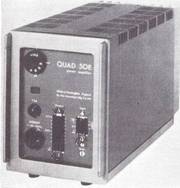Der QUAD 50E - eine ganz spezielle Abwandlung des 303
Dieser "Spezial-Verstärker" liefert knappe 50 Watt Mono- Leistung. Warum der im Hifi-Business propagiert wurde, ist mir wirklich schleierhaft. Wie ich es verstanden habe, gehörte der in den Studiobereich oder ins Labor und weiterhin soll man damit Motoren und Ähnliches betreiben können, so stabil sei er. Angeblich wurden von dem QAUD 50E etwa 12.000 Stück hergestellt (was ich ernsthaft bezweifle) . Hier in Deutschland war er sowohl beim Rundfunk wie auch in den Hifi-Studios völlig unbekannt.
Aber hören wir mal, was der "englische" Tester dazu scheibt :
QUAD POWER AMPLIFIERS
QUAD 50E POWER AMPLIFIER
By Hugh Ford im März 1975
.
Über die Ausführung des Gehäuses
THE MECHANICAL construction of the Quad 50E is very similar to that of the Quad 303 power amplifier, either of which I feel would be quite safe being carted round in a car or falling on a studio floor. The entire rear of the amplifier is taken-up by a very solid heatsink which is combined with a protective cover over the output transistors so that no live parts can be accidentally shorted.
.
- Anmerkung : Dazu muß man noch wissen, daß dieser massive Alu-Kühlkörper mit der Gehäusefarbe lackiert war, was die thermische Wärmeabgabe nicht gerade beschleunigt hatte. Selbst billigste Japan-Netzteile und Verstärker und auch die von RADIO RIM hatten schwarz eloxierte Kühlrippen, die das wesentlich besser konnten.
.
Die Frontplatte
At the front of the amplifier there is also a solid casting which protects the components mounted on the front panel. Between this front casting and the rear heatsink is a good solid casing which can be removed relatively easily for servicing. Inside the case and bottom cover, the majority of the components are mounted on a good quality printed board which can be hinged from within the case in order to gain access to the components.
The front panel houses the main voltage selector, which is of the rotary plug-in type, a pilot lamp, a socket for incoming mains, and the mains fuseholder. The latter is not identified with the fuse value, for which one has to search the instruction book, but in other respects the inputs and outputs are clearly labelled.
Sonderbare "Painton socket" Steckverbinder
The input to the amplifier is connected by an eight way "Painton socket" which gives access to the unbalanced input as well as to the fully floating and balanced transformer input which can be used when the optional extra input transformer is fitted. One further facility on the input socket is a DC output at around +38V from which about 100mA may be drawn for operating auxiliary equipment.
On the output end is a 20 position "Painton socket" fed from some eight completely separate windings on the output transformer. The point of this large number of windings is to enable the amplifier to drive its rated 50W of power into any load between 4 Ohm and 200 Ohm.
Warum keine XLR oder Cinch Buchsen ?
For normal studio use, these input and output arrangements are rather tiresome because the standard XLR connectors will naturally not fit the special input connector. Also, when wiring-up the amplifier output plug for a 4Q or 8Q load, it is necessary to connect some 12 links with the free connector in addition to the loudspeaker leads.
Lastly, on the front panel is the screwdriver operated gain control which is calibrated from 0 to 10 and operates directly across the unbalanced input.
Symmentrischer und unsymmetrischer Eingang
Circuitwise the amplifier is fairly conventional. The signal, either from the unbalanced input or from the optional balanced and centretapped input, is applied to the base of the input transistor via the gain control and a dc blocking capacitor. Feedback from an auxiliary winding on the output transformer is applied to the emitter of this BC109 input transistor, the collector of which drives a Darlington pair phase splitter which in turn is ac coupled to the drivers and output transistors that feed the output transformer.
The operating point of the output stage is adjusted by two preset resistors and is maintained with respect to temperature by means of feedback from a thermistor mounted on the heatsink. The output stages are protected against overload by limiting diodes and also by sampling the driving current to the output transformer and removing the drive if it becomes excessive.
Output power and distortion
As can be seen from fig. 1, which is taken from the manufacturers' literature, there are five different recommended combinations of the output transformer's secondary windings which provide optimum power transfer into 5.8, 12.5, 23, 50, 85 or 200 Ohm. Because the vast majority of modern loudspeakers have a rated impedance of 8 Ohm, the major part of this review was done using the 8 Ohm configuration of output transformer taps which is the optimum for either 4 Ohm or 8 Ohm loudspeakers.
The above figures for output power generally conform to the curves given in fig. 1, but perhaps it would have been more appropriate if the manufacturer had called this a 45 Watt amplifier, not that this makes any practical difference when its output is used for audio purposes.
As is to be expected, the available output power varies with the incoming mains voltage so care was taken during all power measurements to run on precisely the nominal mains voltage.
.
Intermodulation
Investigation into the intermodulation distortion by the SMPTE method revealed a similar pattern to the above with the amplifier operating into an 8 Ohm load and fig. 2 shows the waveform of the input test signal together with the generated distortion products which had a similar waveform at all power levels.
Operation of the amplifier into reactive loads failed to produce any signs of instability and even applying very fast pulses into a load of 8 Ohm in parallel with 2uF did not do anything particularly untoward, as shown in fig. 3 of the resulting output voltage waveform. Working with a fast pulse into a resistive load of 8O hm the slewing rate of the output waveform was measured at 5V/us.
Further testing with a wide variety of tone bursts did not show any signs of deterioration of the burst waveform and recovery from overload after high amplitude bursts was without long term effects.
Frequency response and noise
As has already been seen from the distortion figures, the power response is extremely flat.
+0-1 dB from 30Hz to 22kHz, falling to -3 dB at 40kHz.
Keine Studio-Norm bezüglich 0dB
Virtually identical results were obtained using the balanced transformer input, which offered the same input sensitivity with a common mode rejection of 25 dB up to 1kHz, falling to 21 dB at 20k Hz. The sensitivity for rated output, as is only to be anticipated, varied with the amplifier load, being probably at its worst with 8Ohm loads at 580 mV for 50W output.
Hervorragender Rauschabstand
Amplifier noise far exceeded the manufacturers' specification of 80 dB with respect to 'full output'. The measured hum and noise ('A' weighted) was virtually the same with the inputs open circuit or short circuit, at -103.5 dB(A) with respect to 50W into 8ft. Unweighted noise was masked by hum products, which in fact increased when the unbalanced input was shorted but still remained at a completely satisfactory level as follows:
Hum frequency Level below 50W
50 Hz -109 dB
100 Hz -88.5 dB
150 Hz -108 dB
Other aspects
The input impedance at the unbalanced input and at the transformer input were almost identical and both depended upon the setting of the gain control. At minimum gain the input impedance was 46 kOhm, falling to 16 kOhm at maximum gain. These impedances are quite suitable for bridging 600Ohm and lower impedance lines but the variation in input impedance must be borne in mind for other applications.
At the other end, the output impedance with the transformer tappings set for minimum output impedance was 0.49Ohm in series with 22.9 \lH which is very close to the specification but perhaps offers a rather small damping factor for some loudspeakers.
Summary
Reverting to the 50E, I have no complaints about it meeting its specification, other than being slightly down on power into some loads; in fact it exceeded specification in the majority of parameters, especially with respect to noise. So far as its applications are concerned, it is undoubtedly a very versatile laboratory amplifier for industrial purposes and in this sphere it has much more to offer than the Quad 303 and most other solid state amplifiers.
However, I must admit that I was rather disappointed in its performance as an audio amplifier and, had I taken the trouble to read its specification in detail, I should have realised that its performance is not up to that of the Quad 303 and similar amplifiers from the point of view of a high quality monitoring amplifier.
In fact the Quad 303 is capable of delivering 45W into 8Ohm with far lower distortion than the 50E, and that is 45W per channel with both channels operating. It therefore would appear that the Quad 303 is a far better bargain as a high quality monitoring amplifier and, having used two of them in my laboratory for several years, I can vouch for its performance.
On the other hand, where it is required to drive into loads varying over a wide range of impedances, the 50E is a reasonably priced amplifier which is completely stable. It is both electrically and mechanically robust and offers a more than adequate performance for many applications.
MANUFACTURERS' SPECIFICATION
Power into load: See fig. 1. Maximum power transfer at 5.8, 12.5, 23, 50, 85 and 200Ohm. Power response: -1dB at 30 and 20k Hz referred to 50W.
Distortion with unrestricted bandwidth: 40 Hz <0.35% at up to 50W, 1k Hz < 0.1% at up to 50W, 10kHz <1.0% at up to 50W.
Output source impedance: 0.5O in series with 25uH for 5.5 Ohm connection. Others in direct proportion.
Hum and noise: 80dB referred to full output. Frequency response: 30Hz to 20kHz referred to 1kHz, -1dB unbalanced input, -2dB 600Q bridging input.
Input level: 500 mV for full output, balanced or unbalanced. Preset adjustment for higher levels. Input impedance: Unbalanced: 14 to 50k Q depending on preset gain. 600Q bridging: greater than 14k O in parallel with 50H. Stability: Unconditionally stable with any load. Power input: 110,120, 220 or 240V, 50 to 60 Hz. 24 to 150W depending on signal level.
Manufacturers: The Acoustical Manufacturing Co Ltd, St Peters Road, Huntingdon.



